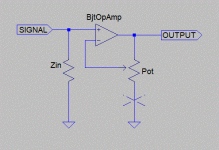Please forgive me if this has been covered somewhere here and I missed it...
It seems to be common wisdom that changing DC levels through a pot will cause scratchy noises when the pot is turned, and that the typical solution is to block the DC path to ground with a cap at point X in the drawing.
My question is why does changing the DC level cause the noise in the first place?
TIA
It seems to be common wisdom that changing DC levels through a pot will cause scratchy noises when the pot is turned, and that the typical solution is to block the DC path to ground with a cap at point X in the drawing.
My question is why does changing the DC level cause the noise in the first place?
TIA
Attachments
When you move the wiper a change in pressure is applied to the track this allows small DC currents to fluctuate due to any unevenness in the pressure applied by the wiper on the track ergo- "scratchy noise" .
wrong point, the wiper must be DC-blocked, not the track. Thus it can't be the DC bias component...Please forgive me if this has been covered somewhere here and I missed it...
It seems to be common wisdom that changing DC levels through a pot will cause scratchy noises when the pot is turned, and that the typical solution is to block the DC path to ground with a cap at point X in the drawing.
The problem is the wiper makes intermittent contact with the track as it moves, which in a feedback circuit will slam the opamp output into the rails causing horrible transients.My question is why does changing the DC level cause the noise in the first place?
TIA
Add 1µF in line with the wiper and a 47k DC bias resistor to ground on the opamp's input. Select a low impedance pot, like 5k or so - then the 47k resistor doesn't load it down too much.
Last edited:
Not wrong point, quite common in fact. Maybe not your preference, as it will allow any DC offset on the non-inverting input to pass through, but that's assuming there's no-blocking on the input, etc.wrong point, the wiper must be DC-blocked, not the track. Thus it can't be the DC bias component...
I wanted to use the simplest depiction of the situation without bringing in extra assumptions.
